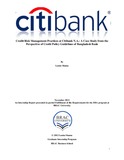| dc.contributor.advisor | Popy, Kulsum | |
| dc.contributor.author | Shama, Lamia | |
| dc.date.accessioned | 2013-05-19T08:39:03Z | |
| dc.date.available | 2013-05-19T08:39:03Z | |
| dc.date.copyright | 2012 | |
| dc.date.issued | 2012-11-04 | |
| dc.identifier.other | ID 08104156 | |
| dc.identifier.uri | http://hdl.handle.net/10361/2432 | |
| dc.description | This internship report is submitted in a partial fulfillment of the requirements for the degree of Bachelor of Business Administration,2012. | |
| dc.description | Cataloged from PDF version of Internship report. | |
| dc.description | Includes bibliographical references (page 56). | |
| dc.description.abstract | Banking industry in Bangladesh has become a major contributor to the economy since the last decade.
Economic prospects and business friendly environment of Bangladesh, foreign banks have come and
opened banking operations here. Of the 9 Foreign Commercial Banks in Bangladesh Citibank N.A. has
been a pioneer in innovative banking services. Citibank N.A. is a concern of Citigroup Inc. located
centrally in New York.
Business entities require a huge amount of money to launch several projects. And money is provided by
the banks in terms of credit. Credit is a contractual agreement in which a borrower receives something of
value now and agrees to repay the lender at some later date. Credit risk means the risk of credit loss which
results from the failure of a borrower to honor the borrower‟s credit obligation to the financial institution.
Bangladesh Bank has formulated Credit Risk Guideline to supervise the process of Credit Risk
Management. As a scheduled foreign bank in Bangladesh, Citibank N.A. complies with that policy and it
has the entire infrastructure in place and activities are performed accordingly. Besides this, in Citibank
N.A. there is a separate Credit Risk Policy named as „ICG Credit Risk Policy‟. This is the global risk
policy for the bank and Citibank N.A. follows this too for the internal compliance. Being a global bank
Citibank N.A. has high risks in its business as it operates globally across 160 countries.
Credit process is a long one and it has several stages. Firstly the borrower‟s application is considered after
examining its financial strength and quality of assets. Based on the financial and asset qualities a risk
grading is tagged to the borrower. The Business unit decides whether the borrower will be provided credit
facility or not. A separate Risk Chain monitors the whole process in collaboration with the business unit.
After decision of lending primary documentation and account opening process is performed by the
respective units and upon perfection of the required documentation, the borrower is provided credit
facilities. Credit related documents are standard documents formulated by the legal team of the bank and
the documents are printed and kept in safe custody of CRMS. For deferrals in documentation, respective
RMs raise deferral request to the Risk Chain who monitors the process from India. Upon perfecting of
documentation CRMS unit maintains the credit lines for the borrowers. Before letting the customer to
take drawdown, CRMS collects the CIB Report from the Database of CIB and checks the status of the
borrower in question. This is a major checking done by CRMS and the Head of CRMS deals with this to
make sure there is no error in the process.
Loan monitoring is solely done by the CRMS unit. RMs as well as business and Risk Chain are informed
about the availed facilities / utilization on a daily basis. Repayment schedules are closely monitored and
classification status of the borrowers changes if there is any discrepancy or delay in repayment schedule.
Thus the whole process goes on in both the pre sanction and post sanction stages.
For hypothecated assets of borrowers, RMs collect the stock reports and insurance cover notes of those
assets so that those assets are safe and available for sale if the customer defaults. Non-performing loan in
Citibank N.A is below 2% and this signifies the perfection of Citibank N.A in managing the credit
portfolio.
CRMS reports to Bangladesh bank as part of the required regulatory reporting. There are 7 monthly
reports, 16 quarterly reports, 6 semiannual reports and 1 annual report which are regularly submitted to
different departments of Bangladesh Bank. The BB officials let CRMS know if there is any discrepancy
and CRMS also obtains clarification from the departments if there is any such requirement. | en_US |
| dc.description.statementofresponsibility | Lamia Shama | |
| dc.format.extent | 64 pages | |
| dc.language.iso | en | en_US |
| dc.publisher | BRAC University | en_US |
| dc.rights | BRAC University Internship reports are protected by copyright. They may be viewed from this source for any purpose, but reproduction or distribution in any format is prohibited without written permission. | |
| dc.subject | Credit risk management | en_US |
| dc.subject | Business administration | |
| dc.title | Credit risk management practices at Citibank N. A : a case study from the perspective of credit policy guidelines of Bangladesh Bank | en_US |
| dc.type | Internship report | en_US |
| dc.contributor.department | BRAC Business School, BRAC University | |
| dc.description.degree | B. Business Administration | |

